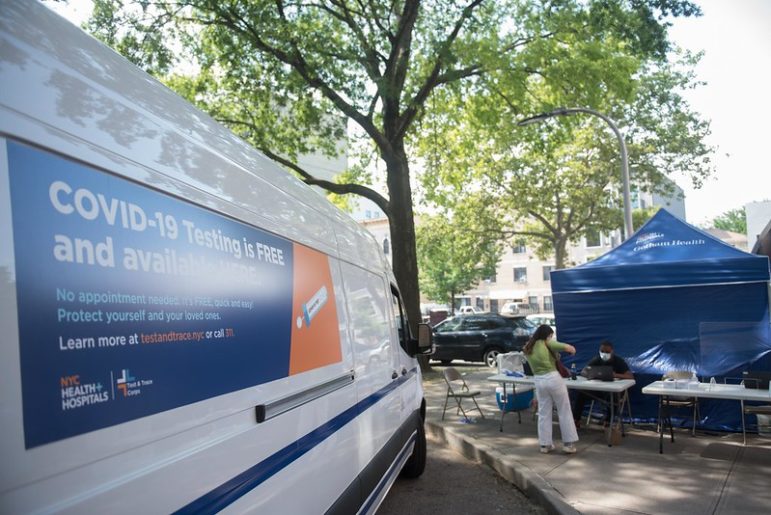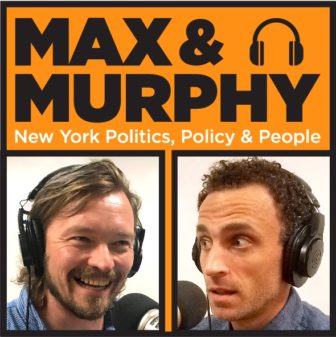
Michael Appleton/Mayoral Photography Office
Free mobile Covid-19 testing site in Ocean Hill Brooklyn seen on Wednesday.New York’s success so far at containing COVID-19 will not translate into anything close to a full recovery of Manhattan office life before 2021, a top business advocate told WBAI’s Max & Murphy Show on Thursday.
“At one point, New York had 28 percent of the world’s deaths at the end of March and early April. We had the worst numbers of any place in the world, including Italy. Today, we look like we know what we’re doing. As the governor keeps pointing out, we have flattened and contained the virus better than almost any place in the country,” said Kathy Wylde, president and CEO of the Partnership for New York City. “That has helped in terms of us knowing how to get out of a crisis but there still is a deep concern.”
“The polling shows that we’re only going to see fewer than 10 percent of employees come back to the office,” Wylde continued. “There are about a million officers workers in Manhattan and … our surveys show that they probably won’t be back, certainly not more than half of them, until after the first of the year.”
Wylde indicated that it would take work to restore New York’s long-term appeal to business leaders and high-income talent. “It has been a wonderful place to attract talent. Ten years ago, you would say ‘Well we couldn’t get a software engineer to move here from San Francisco.’ Well, in the last five years that has changed dramatically. We have got people from all over the world to come to New York.”
“We have got to restore that confidence. That’s what makes our economy work, it’s what makes our universities work great,” Wylde said. “We have to bring all that back.”
The question is how to do that, and how to pay for essential public services until then. In fact, those two concerns are closely linked: If the MTA is drowned by the “fiscal tsunami” of which its leaders have warned, that will affect both short-term survival and long-term appeal.
Wylde warned about calls to increase taxes on the wealthy to close the city and state’s yawning budget gaps. “All of us recognize that tax revenues are important but at the same time, if you raise taxes on billionaires, they’re not coming back. So, you’ll end up losing money that they’re currently paying which is substantial. The top one percent of taxpayers in the city pay 40 percent of the income taxes.” (Of course, the top one percent also make about 36 percent of the income in the city, so their tax share is not as disproportionate as it might at first sound.)
The best hope in the federal government. “We’re confident that Stimulus 4 from the federal government which hopefully will pass in the next ten days will include funding for state and local government. It’s unclear how prescriptive that funding is going to be,” Wylde said. “We are hoping that it’s as broad as possible in terms of making up for the tax losses and the expenditures that both that state and city have incurred.”
Hear the conversation with Wylde below or check out the full show, which included an interview with Public Advocate Jumaane Williams.
Partnership for NYC President and CEO Kathryn Wylde
Max & Murphy Full Show of July 22, 2020
With reporting by Ben Max










2 thoughts on “Fewer Than 10% of NYC Office Workers Expected Back This Year”
If only 10% of office workers return to their desks in 2021 NYC has a big problem on it’s hands. The popularity of WFH (Work From Home) is making Manhattan less important than in the past. The WFH employees tend to be at the higher end of the pay scale too. What’s happening is that these higher-end employees now realize that they can do their jobs just as well from the comfort of their homes. No more subways, buses, MNRR, LIRR, NJT, etc. At least 3 people on my block are doing WFH and they love it. No more long expensive express bus ride from S.I. into Manhattan every day.
Most executives of NYC-based corporations live in the surrounding very well-off suburbs. These decision makers now see that they can do their important work via WFH. They have also seen that they do not need as much, if any, expensive Manhattan real estate for their firm’s operations. The recent virtually unchecked looting of Soho and Macy’s, as well as endless disruptive protests show these executives that NYC is unable to provide a safe environment for their companies and employees. Those pictures of the rioting went out all over the world.
FWIW a local contractor told me that he’s getting a lot of jobs from people building proper WFH spaces in their houses.
NYC has to worry about a bigger problem in 2020 and beyond: a substantial migration of employers and jobs. With current technology, it makes no sense to have any significant operations located in NYC, or the entire Metro area for that matter, where they can be essentially shut down for months on end and disrupted and damaged by violence.
The COVID-19 crisis and the social “unrest” have demonstrated beyond peradventure that the leaders in NYC and Albany are not fit to manage a crisis. The sheer devastation caused by the badly managed mass transit/commuter systems is apparent when you overlay that map with the outbreak map. Literally nothing was done to make that system safer for months after the crisis was declared even though essential workers often relied on it. While Gov. Cuomo seems to be on a perpetual victory lap, according to the IHME projections, NY will have double or more the mortality rate of the states like FL, GA, and TX which have been the targets of his high-handed criticism. Only the very poorly run state of NJ might nose out NY for the highest mortality rate in the US, and the world.